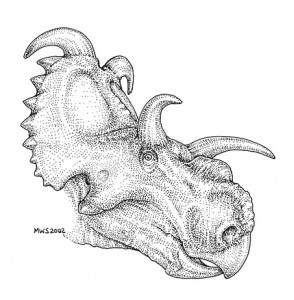Meet an ancestor of Triceratops – Albertaceratops
Say hello to Triceratops’s great, great, etc. Grandfather
On average a new dinosaur species is discovered every six weeks or so. This may surprise you but, if you think about it for a moment, palaeontologists are now excavating parts of the world where there has not been much digging – Antarctica, Argentina and so forth. Also, dinosaurs were around for 160 million years and they diversified into an awful lot of different types – so we have still got plenty of dinosaurs to discover and then describe.
Recently the press covered the announcement of the finding of a new horned dinosaur (a ceratopsian or ceratopsid if you prefer). The animal was called Albertaceratops (Alberta horned face) as it was found in Alberta, Canada. A nearly complete skull of a new Triceratops-like dinosaur was discovered in 2001 and five years later, Dr Michael Ryan of the Cleveland Museum of Natural History, who led the project team, has formerly described it and given it a name – Albertaceratops.
It is a new genus (like a family) of dinosaur, no other remains like this animal had ever been described before. It was unearthed in Southern Alberta from a rock formation called the Oldman Formation – a area of the world we know quite well as part of the Oldman Formation lies within the famous Dinosaur Provincial Park, a part of the world which we have visited and worked in.
Albertaceratops – An Ancestor of Triceratops
The fossil comes from rocks that are about 76 million years old and from research it looks like this animal was a distant ancestor of Triceratops. Albertaceratops had a typical Triceratops-like frill (but with two holes in it called fenestra – means windows) and two prominent brow horns (horns over the eyes). However, it seems not have had a nose horn like its more famous descendant Triceratops, but more like a bump where the nose horn should be. This would have made it look a bit like a Pachyrhinosaurus but with two brow horns.
Artist – Mike Skrepnick
So far only the skull of this animal has been found and this is not complete but it has provided scientists with an insight into the evolution of this particular group of dinosaurs, perhaps the last great dinosaur dynasty to evolve.
Dr Michael Ryan and his team have assigned a species name to this dinosaur. It is known as Albertaceratops nesmoi or A. nesmoi for short. The animal was named after the place where it was found and a local rancher called Cecil Nesmo who has supported palaeontologists by letting them dig on his land.
Our thanks to Dr Michael Ryan for his assistance with this article and Mike Skrepnick for permission to use his illustration.
Visit the Everything Dinosaur website: Everything Dinosaur.


